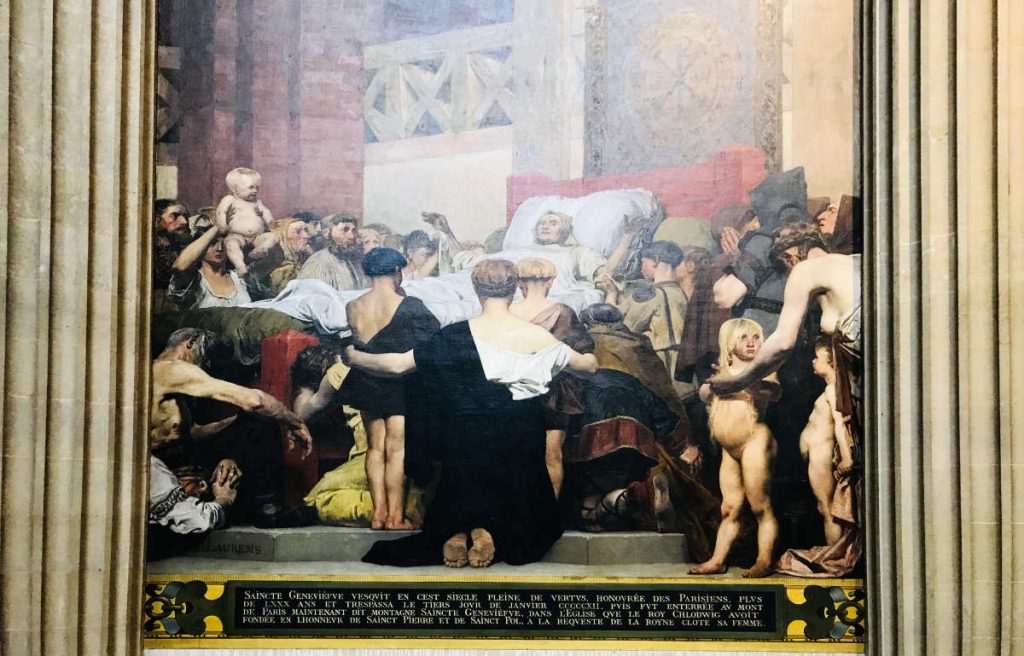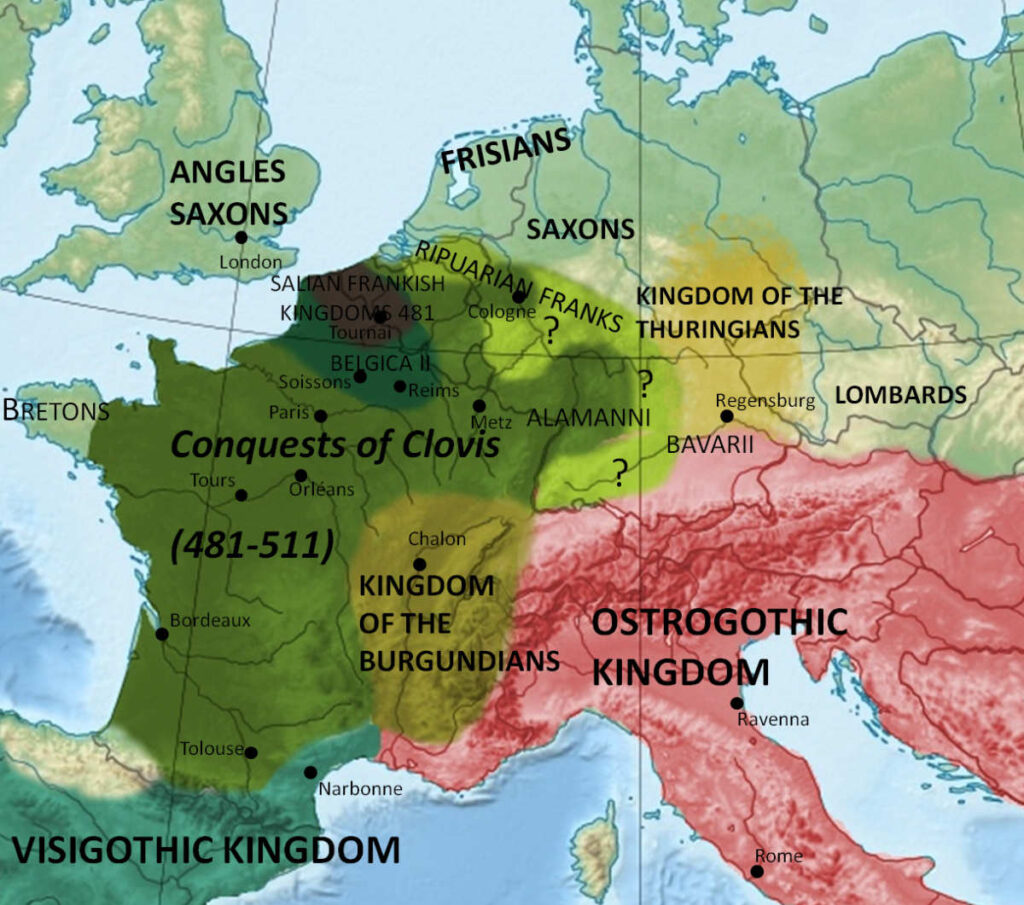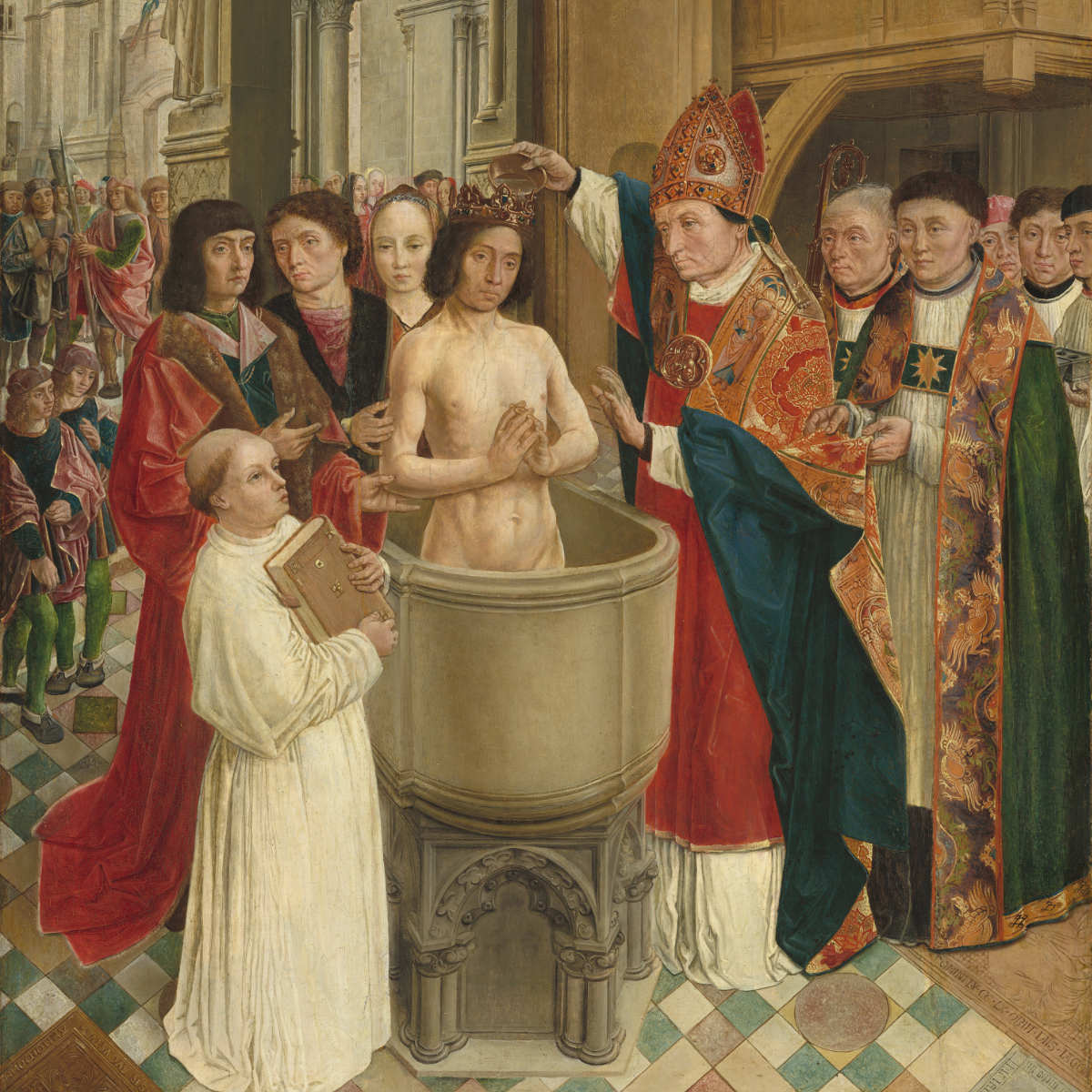In chronicals of French history, there was one ruler to unite them all. And that would be Clovis I, who is famously considered the 1st King of France.
After the fall of the Roman Empire, the various local tribes of Franks and Gauls were vying for control. It was Clovis I who would be crowned King and unite the various Frankish tribes in Gaul under one ruler.
It is under his legacy that the Kingdom of Francia (Kingdom of the Franks) would later become the modern-day country of “France” that we all know and love today.
But Clovis didn’t just stop at becoming the 1st King of the Franks. He also got on the religious bandwagon that was progressing across Europe at the time. It was Clovis’s conversion to Christianity that really made him so popular, and a saint to boot.
At the time, paganism, Catholicism, and Arianism were all actively practised across Europe. Picking a religion was more about politics than heartfelt devotions.
Clovis I decided to be baptized based on the urging of his wife Clotilde, herself a very pious believer. And with that the legend of Clovis would spread far and wide, and his heirs became part of the Merovingian dynasty, considered the first French royal family.
So let’s explore the life of Clovis I, from his marriage and family to his conquests and achievements, along with much much more. Allons-y!
| Quick facts | |
|---|---|
| Birth: | around 466 AD in Tournai (present-day Belgium) |
| Death: | 27 November 511 at age 45 in Paris, Francia |
| Parents and siblings: | King Childeric I of the Salian Franks, and Basina, a Thuringian princess |
| Reign: | 481 – 509 AD |
| Marriage and kids: | Saint Queen Clothilde (493-511), 5 children |
| Famous for: | Converting to Christianity and becoming the 1st King of the Franks (now France) |
1. He was born in 466AD.
Clovis I was born in 466AD in the town of Tournai, in what is today in Belgium. He was the son of Childeric I, a Merovingian king of the Salian Franks tribe. His mother Basina, was a Thuringian princess from a Germanic tribe.
His family claimed to be related to the famed Merovech who was possibly part of the alliance that defeated Attila the Hun in 450AD and started the Merovingian dynasty.
At the time, there were numerous Frankish tribes in the area that settled the area known as Gaul, under the rule of the Roman Empire which was in decline.
As the vast majority of people were illiterate at the time, most of what we know of Clovis comes from 6th century historian Gregoire de Tours, who wrote a hagiography.
2. He became King at 15 years-old.
Clovis’s father Childeric I died when Clovis was 15 years-old, making Clovis the King of his Frankish tribe. Clovis immediately started conquering neighboring territories, while at the same time entering into alliances to expand his base support.
Along with conquering parts of Gaul controlled by the other tribes, he tried to take over territories controlled by the Roman clergy. He came to realize that he wouldn’t be able to rule Gaul without the help of the clergy so decided to take a Catholic wife.
3. He married Clotilde who was a dedicated Catholic.
In 493AD, Clovis decided to marry a local princess named Clotilde who was from Lyon. Importantly, Clotilde was Catholic, which was unusual at the time, as paganism and arianism were the popular religions.
And because Clotilde was Catholic like the Romans, this ensured that Clovis became Catholic. This meant that he had the support of the Byzantine – Eastern Roman Empire who were also Catholic in his wars against his rivals.
Their marriage was considered an important union in Christianity. By the 6th century, the marriage of Clovis and Clotilde was made the theme of various stories, songs, and ballads.
4. Clotilde convinced Clovis to convert to Christianity.
Within a few years of their marriage, Queen Clotilde convinced Clovis to convert to Christianity. This would also help Clovis get the Roman Catholic clergy on his side, something that was of vital importance.
King Clovis was baptized on Christmas Day in 508AD in Reims, along with 3000 of his warriors and his two sisters. The Reims cathedral that stands on the spot where he was baptized became one of the most important cathedrals in France.
The adoption of Catholicism by Clovis led to widespread conversion among the Frankish peoples who had previously followed pagan traditions.

Three centuries later, his successor King Charlemagne would form an alliance with Papal Rome and become Holy Roman Emperor, making Christianity the main religion in Europe.
5. He and his wife had 5 children.
Clovis and Clotilde would have 5 children, 4 of whom would grow into adulthood. There was Ingomer who died as a baby, and 3 boys named Clodomir, Childebert, and Clotaire, as well as a girl named Clotaire.
6. He had an older son out of wedlock.
It is not clear what other relationships Clovis I had, or if he had been married before. However, he did have another son named Theuderic who he did acknowledge and would leave a portion of his kingdom to.
Theuderic was older than his children with Clotilde, and was an active advisor and companion to his father. After Clovis’s death, Clotilde would try to ensure that her sons were not disadvantaged by Theuderic taking the lead as King.
7. He made a nun named Genevieve his advisor.
When Clovis’s father Childeric I laid siege to Paris in 465AD, it was a pious nun named Genevieve who would negotiate on behalf of the city’s citizen and arrange for a ceasefire.
Genevieve was thought to have visions of God and was a devout Catholic. By the time King Clovis and Queen Clotilde came to the throne, Genevieve was highly revered. Clotilde was a big supporter of Genevieve, extolling her virtues to Clovis as well as the local population.
Under Genevieve and Clotilde’s encouragement, Clovis built a church dedicated to Saints Peter and Paul that today bears the name of Montagne Sainte-Geneviève next to the Pantheon in the 5th arrondissement of Paris.
8. Saint Genevieve advised him to make Paris his capital.
It is through the influence of Genevieve that Clovis I established Paris his capital in 508AD. At the time, most of the city’s settlement was on Ile de la Cité and its strategic location on the River Seine made it a good location for trade, as well as a good defensive position.

Genevieve died at the age of 89 in 502AD, and was venerated as a saint due to the efforts of Clovis and Clotilde who both held her in high regard. Today, she is considered the patron saint of Paris.
☞ READ MORE: 32 Interesting facts about Paris
9. He would conquer much of Gaul.
Clovis I expanded the territories he inherited, and would go on to defeat the Romans in Gaul, Nouvelle Aquitaine to the Pyrenees mountains, Burgundy, and even going as far as Provence.

While he would eventually lose Provence to the Visigothic Kingdom (today Spain), Clovis is known for uniting much of Old Gaul, what is today known as France.
☞ READ MORE: 40 Incredible facts about France
10. He made the Fleur de Lys his symbol.
Clovis I is believed to have been the 1st King to make the fleur de lys his personal symbol and thus in time the symbol of the French monarchy. The symbol derives from the lily flower, which itself symbolizes purity and the Virgin Mary.

Thus the fleur de lys came to symbolize and commemorate the conversion of Clovis I.
It became the official symbol of French royalty and continues to adorn monuments and châteaux all over France. It also adopted by other European Royal houses, as intermarriage between the royal families became common.
The French fleur de lys was abolished after the 1789 French revolution and replaced by the symbol of Marianne.
11. He died at the age of 45.
Clovis I is believed to have died on November 27, 511AD at the age of 45 after a short illness. Upon his death, his kingdom was divided amongst his 4 surviving sons as was the tradition at the time:
- Theuderic – Rhine and Champagne regions, capital in Reims
- Clodomir – Loire, capital in Orleans
- Childebert I – Normandy, capital in Paris
- Clotaire I – North of Gaul, capital in Soissons
All four set up their respective capitals a short distance from each other, which was meant to help maintain the unity of the kingdom.
12. He was buried in Paris.
Prior to his death, Clovis decided that he wanted to be buried in Paris. He was believed to be buried in the Abbaye Sainte-Geneviève de Paris, next to the tomb of Saint Genevieve. Today, it is part of the famous Parisian high school Henri IV.
Subsequent excavations at the abbey have not shown any tombs from the Merovingian era, so it is possible they were evacuated at some point during Paris’s long history. However, the shrine of Saint Genevieve can be found in Eglise St. Etienne du Mont church in Paris.
By deciding to be interred in Paris, Clovis I gave the city a symbolic weight. When his grandchildren divided royal power, Paris still regarded as as a joint property and a symbol of the Merovingian dynasty, adding to the city’s importance.
13. His wife Clothilde was venerated as a Saint.
Queen Clotilde was venerated as a saint in around 550AD by the Roman Catholic Church as well as by the Eastern Orthodox Church for the role she played in her husband’s famous conversion to Christianity. She was buried next to her husband at the Abbaye Sainte-Geneviève de Paris.
There were some attempts in later centuries for Clovis I also to be venerated as a saint in France. However, he was never beatified.
14. His story was told by Gregory of Tours.
Much of Clovis’s fame is due to a series of books written about his life by Gregory of Tours. Gregory was a Gallo-Roman historian and the Bishop of Tours. His “Histories” were released approximately 50 years after Clovis’ death.
Writing from a Christian perspective, the books contained Christian tales of miracles, stories of Christian martyrs, Bible verses, etc. In them, Clovis is depicted as a noble warrior of the Christian faith.
He describes in florid detail Clotilde’s arguments for convincing her husband to convert, likening it to the conversion of Constantine to Christianity.
15. The name Clovis has many modern derivatives.
The name Clovis is an old Frankish boy’s name and is not heard often any more. However, its more modern versions are actually quite common:
- Louis – French
- Lewis – English
- Ludwig – German
- Lodewijk – Dutch
Louis would go on to become a favorite name of the French royals, with at least 19 different Kings of France having that name.
16. His legend lives on.
Clovis I was known as being the founder of the Merovingian Royal line as a decendant of Merovech. If you are wondering where you heard that name before, you may be remembering your Dan Brown novels.
The books claimed that Mary Magdalene who arrives in Provence (see her tomb here) carrying Jesus’s child, marries their descendants into French nobility and becomes the Merovingian Royal line.
While we can assume this is quite a bit of creative license, Clovis I is considered by French people to be the founder of France after whom the country took its name, Francia.

If you enjoyed that article, you may like to read more about other important moments in French history. A bientôt!




